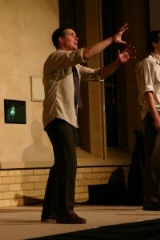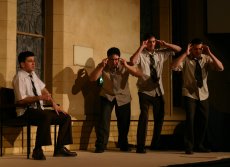
Biblical storytelling
Encyclopedia
Biblical storytelling is a discipline in which the storyteller
takes a passage from the Bible
, studies and reflects on that passage, and then tells it in a way so that the hearers may best connect with the story
as well. This is often done by learning the words of the story by heart and acting out the story whilst telling it. Traditionally this is done with narrative sections in the Bible, yet Biblical storytelling has been used with other Biblical genres as well.
of the Biblical time-period, understanding that the normal mode of engaging with the Bible during this time was through the public reading of scripture or in the retelling of stories. Modern Biblical storytelling as a discipline may be traced to Tom Boomershine who experimented with the idea of memorising stories in the Bible and telling them during seminary
. In 1977, he together with Gil Bartholomew (now Adam Bartholomew) then went to begin the Network of Biblical Storytellers (NOBS). Biblical storytelling guilds began to start internationally with Australia
in 1990, Canada
in 1996, the United Kingdom
and in Singapore
.
is rarely used when describing storytelling because it usually is taken to mean rote learning
. Instead the process is described as 'internalization' or 'committing to deep memory' . As a result of this process the general expectation is that the storyteller will be able to tell the story with 95% content accuracy and 75% verbal accuracy. Techniques may be used as follows:
 Presenting a story from the Bible borrows many techniques from acting
Presenting a story from the Bible borrows many techniques from acting
, yet in many ways it is quite a distinct art form. Instead of solely taking on one character, the storyteller describes the entire scene in the imagination of the audience. Because storytelling is usually done without many props
or sets, this requires the storyteller to visualise the scene of the story in order to describe it physically whilst telling the story. A number of techniques may be used:
 In a theatrical Biblical Storytelling performance with multiple storytellers, there may be only one speaking storyteller at a time, so the other storytellers may be used to enhance the telling in the following ways:
In a theatrical Biblical Storytelling performance with multiple storytellers, there may be only one speaking storyteller at a time, so the other storytellers may be used to enhance the telling in the following ways:
Storytelling
Storytelling is the conveying of events in words, images and sounds, often by improvisation or embellishment. Stories or narratives have been shared in every culture as a means of entertainment, education, cultural preservation and in order to instill moral values...
takes a passage from the Bible
Bible
The Bible refers to any one of the collections of the primary religious texts of Judaism and Christianity. There is no common version of the Bible, as the individual books , their contents and their order vary among denominations...
, studies and reflects on that passage, and then tells it in a way so that the hearers may best connect with the story
Bible story
Bible stories, Judeo-Christian parables retelling some portions of the Bible, have been used in family religious worship, spiritual instruction and literature in Christian and Jewish societies....
as well. This is often done by learning the words of the story by heart and acting out the story whilst telling it. Traditionally this is done with narrative sections in the Bible, yet Biblical storytelling has been used with other Biblical genres as well.
History
Biblical storytellers place themselves in line with the oral traditionOral tradition
Oral tradition and oral lore is cultural material and traditions transmitted orally from one generation to another. The messages or testimony are verbally transmitted in speech or song and may take the form, for example, of folktales, sayings, ballads, songs, or chants...
of the Biblical time-period, understanding that the normal mode of engaging with the Bible during this time was through the public reading of scripture or in the retelling of stories. Modern Biblical storytelling as a discipline may be traced to Tom Boomershine who experimented with the idea of memorising stories in the Bible and telling them during seminary
Seminary
A seminary, theological college, or divinity school is an institution of secondary or post-secondary education for educating students in theology, generally to prepare them for ordination as clergy or for other ministry...
. In 1977, he together with Gil Bartholomew (now Adam Bartholomew) then went to begin the Network of Biblical Storytellers (NOBS). Biblical storytelling guilds began to start internationally with Australia
Australia
Australia , officially the Commonwealth of Australia, is a country in the Southern Hemisphere comprising the mainland of the Australian continent, the island of Tasmania, and numerous smaller islands in the Indian and Pacific Oceans. It is the world's sixth-largest country by total area...
in 1990, Canada
Canada
Canada is a North American country consisting of ten provinces and three territories. Located in the northern part of the continent, it extends from the Atlantic Ocean in the east to the Pacific Ocean in the west, and northward into the Arctic Ocean...
in 1996, the United Kingdom
United Kingdom
The United Kingdom of Great Britain and Northern IrelandIn the United Kingdom and Dependencies, other languages have been officially recognised as legitimate autochthonous languages under the European Charter for Regional or Minority Languages...
and in Singapore
Singapore
Singapore , officially the Republic of Singapore, is a Southeast Asian city-state off the southern tip of the Malay Peninsula, north of the equator. An island country made up of 63 islands, it is separated from Malaysia by the Straits of Johor to its north and from Indonesia's Riau Islands by the...
.
Internalization
The term memorizationMemorization
Memorization is the process of committing something to memory. The act of memorization is often a deliberate mental process undertaken in order to store in memory for later recall items such as experiences, names, appointments, addresses, telephone numbers, lists, stories, poems, pictures, maps,...
is rarely used when describing storytelling because it usually is taken to mean rote learning
Rote learning
Rote learning is a learning technique which focuses on memorization. The major practice involved in rote learning is learning by repetition by which students commit information to memory in a highly structured way. The idea is that one will be able to quickly recall the meaning of the material the...
. Instead the process is described as 'internalization' or 'committing to deep memory' . As a result of this process the general expectation is that the storyteller will be able to tell the story with 95% content accuracy and 75% verbal accuracy. Techniques may be used as follows:
- Making sure the script is easy to read
- Breaking up the story into scenes
- Identifying key words and phrases
- Identifying locations
- Investigating and understanding characters
- Tracking the emotional journey
- Understanding how the story functions in the wider context
Presentation

Acting
Acting is the work of an actor or actress, which is a person in theatre, television, film, or any other storytelling medium who tells the story by portraying a character and, usually, speaking or singing the written text or play....
, yet in many ways it is quite a distinct art form. Instead of solely taking on one character, the storyteller describes the entire scene in the imagination of the audience. Because storytelling is usually done without many props
Theatrical property
A theatrical property, commonly referred to as a prop, is an object used on stage by actors to further the plot or story line of a theatrical production. Smaller props are referred to as "hand props". Larger props may also be set decoration, such as a chair or table. The difference between a set...
or sets, this requires the storyteller to visualise the scene of the story in order to describe it physically whilst telling the story. A number of techniques may be used:
- Locations - Using consistent places in the space for locations and characters in the story.
- Reacting - Acting as an emotional guide for the audience.
- Gesturing - Pointing or gesturing to show the audience where objects are in the imaginary scene.
- Miming - Interacting with things or characters to give them a tangible reality.
- Acting Out - Demonstrating events or actions whilst talking about them.
- Characterization - Using different tones of voice/accents or different stances to distinguish different characters and to give them depth and meaning.
Single Person Performances
Much of Biblical Storytelling is done as a single storyteller learning one story from the Bible and performing it:- when the Bible passage would normally be read (e.g. in Church meeting)
- as a special drama for an occasion (the death and resurrection of Jesus for an Easter event)
- in a meeting of storytellers to share stories
Epic storytelling
At events where storytellers are gathering together, an Epic Storytelling may be set where different parts of the longer story are distributed to those coming together before the gathering and the epic story is told at the event with each of the storytellers telling their sections.Ensemble Storytelling

- by being non-verbal characters in the scene
- to be part of the set
- lines could be distributed or said in unison for dramatic effect
- by adding a soundscape (e.g. cheering, mourning, laughing or making sound effects)
See also
- Bible storyBible storyBible stories, Judeo-Christian parables retelling some portions of the Bible, have been used in family religious worship, spiritual instruction and literature in Christian and Jewish societies....
- List of Bible stories
- Network of Biblical Storytellers - An international Biblical Storytelling organization
- The Backyard Bard - An Australian Biblical Storytelling theatre company
- Christian dramaChristian dramaChristian drama is drama that explores Christian themes.- Mystery play :Through the medieval period churches in Europe frequently performed mystery plays, retelling the stories of the Bible. They developed from the representation of Bible stories in churches with accompanying song...
- Oral traditionOral traditionOral tradition and oral lore is cultural material and traditions transmitted orally from one generation to another. The messages or testimony are verbally transmitted in speech or song and may take the form, for example, of folktales, sayings, ballads, songs, or chants...
External links
- Dennis Dewey - A Professional Biblical Storyteller
- The Backyard Bard Website
- One Man Show Ministries-- a Christian Drama Ministry featuring Costumed Monologues

